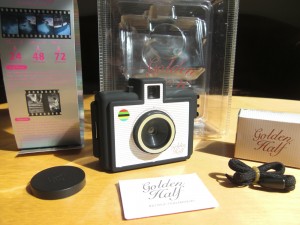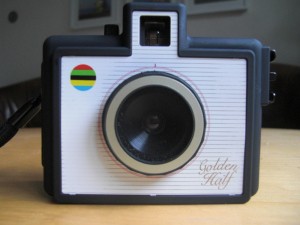
The GOLDEN HALF is a 35mm half-format plastic camera. I discovered it recently while browsing through some alternative camera sites, and since it takes odd 18x24mm pictures (that’s two in the space of a “normal” 24x36mm negative), I decided I had to have it.
After 4 weeks and several rolls of film, here’s my two cents.
I discovered this camera at the London Photographer’s Gallery, experts and stockists for plenty of Holga & Co schnick-schnack. At £35 not bad for Central London prices (hey, it even comes with a film in the box).
History
Rumour has it that the Golden Half was produced for a project by/for Ina Babylon and a book called “Life as a Golden Half”. I’m quoting from memory here, as I’ve not seen a copy of this book or found anything about this project. The name Ina Babylon may or may not refer to an actual person, it certainly is associated with the Superheadz Website, aka the makers of this rubberized pocket gadget. The entire site is in Japanese, a language fascinating yet very much a mystery to me.[singlepic id=436 w=320 h=240 float=right]
Luckily though, the manual is in English and even funny at times.
In a nutshell it explains the features of the camera and it all comes in a shiny plastic box, stating that you can take twice the amount of ordinary 35mm pictures (48 on a 24 roll, 72 on a 36 roll – you get the picture). It achieves this by taking a fairly small picture on a piece of film, comparable to that of 35mm motion picture cameras.
This idea isn’t new, and in fact goes way back. Had it not been for the ultimate source of all knowledge Paul Weston, I’d never have known. Apparently, Olympus made an entire SLR system around half format called the Pen F series. Very small cameras for the time (we’re talking the late 60ies here), and a whole arsenal of lenses was available. Paul even owned such a camera and says it took cracking pictures – until someone stole it from him in a changing room in Australia.
[singlepic id=437 w=320 h=240 float=right]
The main oddity of half-frame or half-format is that while holding the camera landscape, you’re actually taking a portrait picture, and vice versa. It’s like using the 645 gate with a Holga. It’s odd, but you get used to it quickly.
The other side effect of half-format of course is the image quality.
Paul remembers that for 6×4″ prints you don’t see a difference, but of course if you go bigger than that, grain starts becoming very visible. That’s not necessarily a bad thing; I for one am immediately thinking of funky black and white effects and overdeveloped HP5 film for an extra scoop of spookiness (see examples).
What’s in the Box
The camera comes in a choice of black or blue. Mine is black with a rubberised finish – like some versions of the Lomography Sumpersampler.
- 1x Golden Half camera
- 1x hand strap
- 1x 400 ASA Kodak film (in a matching Golden Half box)
- 1x Lens Cap
- 1x tiny Manual, about the size of a 35mm film box. Cute!
There’s an inscription on the back, explaining the basic concept. It finishes with “So throw away your book and why don’t you go out”. I love it already!
Features
The Golden Half features a very wide lens, 22mm as the manual states. That’s probably the actual focal length of the lens, which means at a smaller frame size, this would appear even wider. A quick glance through the viewfinder confirms this – without fisheye distortion, you can capture A LOT at a time, making this an ideal tool of candid street photography. Cartier-Bresson would have loved it. Be careful though that you don’t go up too close, minimum focusing distance is 1.5 meters (60 inches) according to the manual. In reality, I’ve not had anything out of focus though.

Hi! You seem like bit of an expert so i was wondering if you could explain this for me…. i bought this camera last week but my instructions are in chinese! after i take a picture do i just wind on for the second one on the same frame? or is there some fancy way it works? thanks 😀 x
@katie
Ah, Chinese instructions… that’s no good (unless you’re Chinese of course). Take a look at this – courtesy of the Holga Magic website.
You are quite right: take a picture, then wind the knob until it stops – now you’re ready for the next exposure. Each picture you take is 18x24mm on the negative, so when you give the film to the lab, they’ll print it as if you shot 24x36mm – hence you end up with two pictures side by side.
Have fun 😉
Hi, thanks a lot for your review on Golden Half! Just purchased one goldie myself! 🙂
I’m wondering if it’s possible to add on lens like fish eye on the golden half? e.g. buy holga’s fish eye lens and add it onto holga..
@ Pixie
Glad you liked the review – have fun with your new Goldie!
There’s no thread around the lens area of the Golden Half, so you won’t be able to attach any accessories or filters. However, there’s nothing stopping you from holding one in front of the camera while you take the shot! I’ve used the Holga Fisheye Adaptor many times on other cameras and the results are rather cool. Give it a shot 😉
The Golden Half is fantastic, fun little camera. I’ve owned two (first one was stolen) and both have the peculiar quality (due to the relatively cheapo plastic lens I’m guessing) of giving many pictures a sort of “tilt-shift” effect whereby there’s a sharp band across the middle of the photo with top and bottom areas out of focus. It can be a pretty cool effect actually and it’s this kind of quirk that makes me love plastic cameras.
Hi, I’d like to know if the camera can only be used like in the day when you dont have those external flash.
I bought that book “Life As a Golden Half” a couple of days ago. I saw it in Giant Robot SF and immediately bought it.
What’s it about? I’ve never seen it to have a browse. Any good Golden Half shots in it?
Hello! Thank you for your informative article (:
I got a Golden Half for my birthday last May. I was excited but first batch of photos didn’t turn out well. Almost half of the negatives are spoilt. I wasn’t sure if it was overexposed or just blanks.
May I ask how to do know when the film roll is done? If I were to use a 24exp film, once the the film counter reach 48, do I then rewind the film immediately? Or do I just shoot until I can’t shoot anymore?
I hope you can clarify this for me. Thank you.. (:
Hi Jannah,
you can shoot until the film doesn’t wind forward anymore – you’ll notice the resistance when you wind to the next picture. Then it’s time to rewind.
For best results, shoot outdoors or indoors with a flash. Use 400 ISO film or higher (say 800 or 1600). Good luck 😉
Ahh, thanks alot for the info! (: The other time I did shoot few times more after 48 but then my friend got worried and asked me to just rewind. We had difficulty rewinding as this is our first time and peeked open the flap a little to see what’s happening. That would explain how the last few photos got spoilt. But do you have any idea what could cost the middle bunch of my photos were simply, missing..?
Also, most of the salesperson at the photo developing shops I went to doesn’t recognize what cross-processing mean. Would the result be significantly different? And would you recommend using slide film for Golden Half?
Sorry for lengthy message. Thank you once again.. (:
correction: “what could cost the middle bunch of my photos to be missing..” (there were just blanks in the negative)
Blank pictures on a negative are usually caused by either severe underexposure (i.e. it was so dark you can’t see a thing) or you left the lenscap on – I did that before 😉 Or your shutter isn’t working properly. You can test it by opening the back, pointing the camera at a light and take a picture. If it’s working fine, you should see it opening – if you don’t see it, it may be bust.
On a 24 exposure roll there’s usually 27-28 pictures on there so you’ll easily get up to 50+ exposures with the Golden Half.
Cross Processing is usually done by using slide film which is processed in C-41 chemicals (for negative film). The results can be pretty, but most slide film is 100 ISO or even lower, which means you need very strong light for best results (i.e. outdoors in strong sunlight or indoors with a flash). I’d say leave it for now – but it’s certainly a challenge down the line.